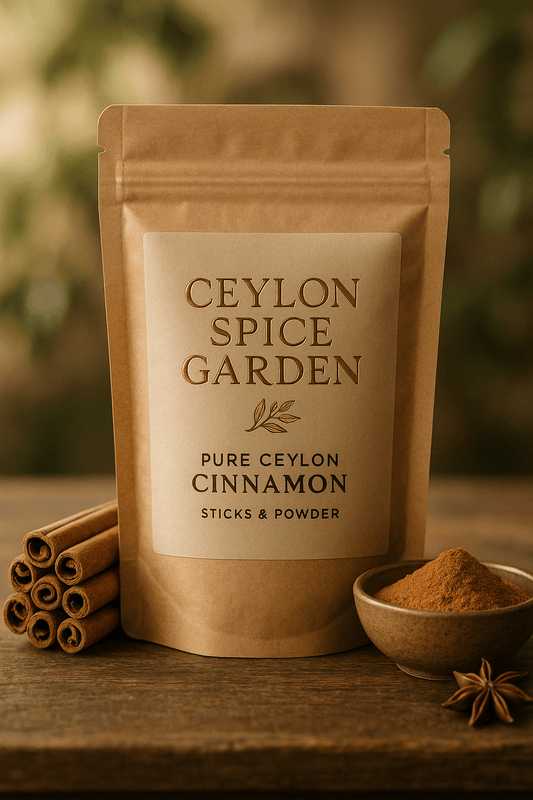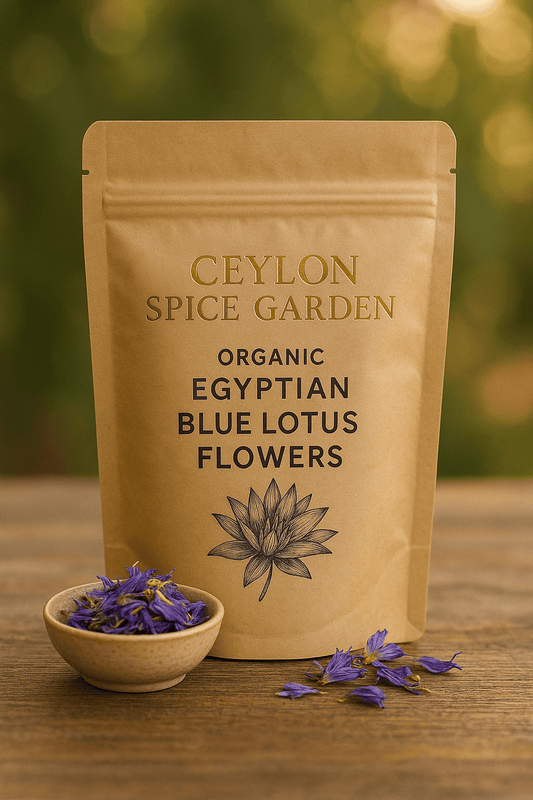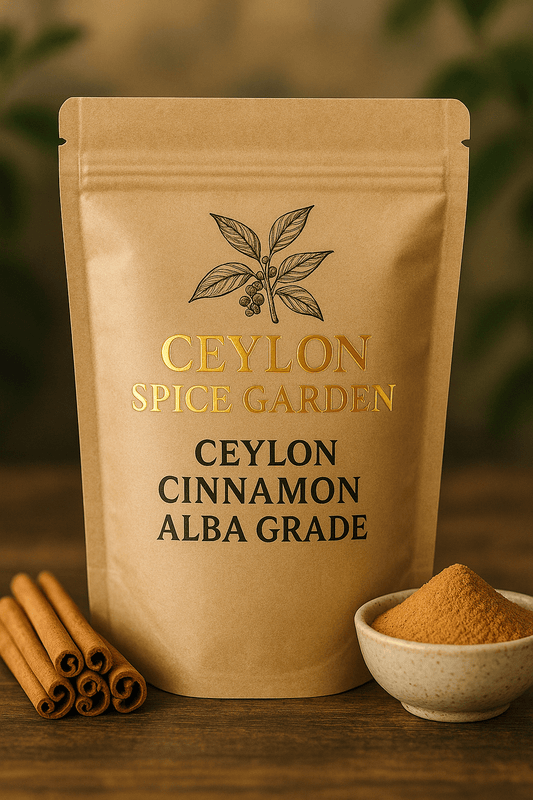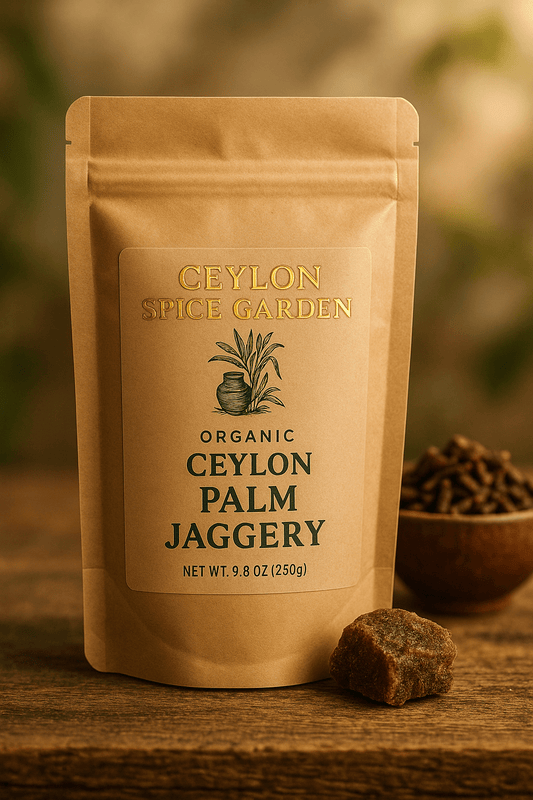
Making DIY Spice-Infused Oils with Sri Lankan Herbs | Complete Guide | Ceylon Spice Garden
Making DIY Spice-Infused Oils with Sri Lankan Herbs: Complete Artisan Guide
Table of Contents
- Introduction & Benefits of Sri Lankan Spice Oils
- Essential Equipment & Materials
- Choosing the Right Base Oils
- Best Sri Lankan Herbs & Spices for Oil Infusion
- Three Professional Infusion Methods
- Step-by-Step Creation Guides
- Signature Sri Lankan Oil Blend Recipes
- Safety Guidelines & Best Practices
- Storage & Preservation Techniques
- Creative Applications & Uses
- Troubleshooting Common Issues
- Quality Testing & Evaluation
- Frequently Asked Questions
Introduction & Benefits of Sri Lankan Spice Oils
Making DIY spice-infused oils with Sri Lankan herbs allows you to capture the therapeutic properties and exotic flavors of Ceylon's legendary botanicals in long-lasting, versatile preparations. These artisanal oils serve multiple purposes from culinary enhancement to aromatherapy and natural wellness applications.
Why Create Sri Lankan Spice-Infused Oils?
- Concentrated Flavors: Extract and preserve the essential oils from fresh herbs and spices
- Extended Shelf Life: Oils last 6-12 months compared to weeks for fresh herbs
- Versatile Applications: Use for cooking, massage, aromatherapy, and skin care
- Cost-Effective: Make professional-quality oils at home for fraction of retail cost
- Therapeutic Benefits: Harness the medicinal properties of Sri Lankan botanicals
- Customization: Create unique blends tailored to your preferences and needs
Essential Equipment & Materials
Professional results in DIY spice oil making require the right tools and equipment. Here's everything you need to create high-quality Sri Lankan herb-infused oils at home.
Basic Equipment List
| Equipment | Purpose | Budget Option | Professional Option |
|---|---|---|---|
| Glass Jars | Infusion containers | Mason jars (8-16 oz) | Dark amber glass jars with tight lids |
| Straining Equipment | Remove plant material | Fine mesh strainer + cheesecloth | Multiple mesh sizes + coffee filters |
| Heat Source | Gentle warming (optional) | Stovetop with double boiler | Dehydrator or warming plate |
| Storage Bottles | Final product storage | Dark glass bottles 2-4 oz | UV-protected bottles with droppers |
| Labels | Identification and dating | Masking tape + marker | Waterproof labels + fine-tip marker |
Choosing the Right Base Oils
The foundation of excellent Sri Lankan spice-infused oils is selecting the appropriate carrier oil. Different base oils offer varying benefits, flavors, and shelf lives.
Extra Virgin Olive Oil
Shelf Life: 12-18 months
Smoke Point: 375°F (190°C)
Best For: Culinary oils, Mediterranean-style blends, cold infusions
Sri Lankan Pairing: Curry leaves, lemongrass, pandan
Coconut Oil
Shelf Life: 24+ months
Smoke Point: 350°F (175°C)
Best For: Tropical blends, skin care, hair treatments
Sri Lankan Pairing: Cinnamon, cardamom, cloves
Sesame Oil
Shelf Life: 18-24 months
Smoke Point: 410°F (210°C)
Best For: Asian-inspired blends, high-heat cooking
Sri Lankan Pairing: Ginger, turmeric, fennel
Avocado Oil
Shelf Life: 12-24 months
Smoke Point: 520°F (270°C)
Best For: High-heat applications, neutral flavor base
Sri Lankan Pairing: Any spice, versatile base
Jojoba Oil
Shelf Life: 48+ months
Smoke Point: N/A (cosmetic use)
Best For: Aromatherapy, skin care, massage oils
Sri Lankan Pairing: Sandalwood, vetiver, citronella
Sunflower Oil
Shelf Life: 12-18 months
Smoke Point: 440°F (225°C)
Best For: Budget-friendly option, neutral base
Sri Lankan Pairing: Strong spices like cloves, nutmeg
Best Sri Lankan Herbs & Spices for Oil Infusion
Ceylon's tropical climate produces herbs and spices with exceptionally high essential oil content, making them perfect for infusion projects. Here are the top choices for creating authentic Sri Lankan flavored oils.
Top-Tier Sri Lankan Aromatics
Ceylon Curry Leaves
Infusion Strength: Strong, fast-infusing
Best Method: Cold or warm infusion
Flavor Profile: Citrusy, nutty, aromatic
Uses: Cooking oils, hair treatments
- Use fresh leaves when possible
- Infuses within 24-48 hours
- Excellent for beginner oil makers
Ceylon Lemongrass
Infusion Strength: Very strong
Best Method: Cold infusion
Flavor Profile: Bright citrus, herbaceous
Uses: Aromatherapy, insect repellent, cooking
- Use lower stalks and leaves
- Bruise before infusing for better extraction
- Natural preservative properties
Ceylon Cinnamon
Infusion Strength: Medium, slow release
Best Method: Warm infusion
Flavor Profile: Sweet, warm, delicate
Uses: Culinary oils, massage oils
- Use bark pieces, not powder
- Requires 2-4 weeks for full infusion
- True Ceylon cinnamon has complex sweetness
Ceylon Cardamom
Infusion Strength: Strong, aromatic
Best Method: Warm or solar infusion
Flavor Profile: Intensely aromatic, slightly sweet
Uses: Perfumed oils, culinary applications
- Lightly crush pods before infusing
- Remove seeds for cleaner oil
- Expensive but highly potent
Ceylon Cloves
Infusion Strength: Very strong, can be overpowering
Best Method: Cold infusion with careful timing
Flavor Profile: Intense, warming, numbing
Uses: Therapeutic oils, dental care
- Use sparingly - very potent
- Monitor closely to prevent over-infusion
- Excellent antimicrobial properties
Ceylon Nutmeg & Mace
Infusion Strength: Medium, complex extraction
Best Method: Warm infusion
Flavor Profile: Warm, sweet, slightly psychoactive
Uses: Culinary oils, aromatherapy
- Grate fresh for best results
- Use mace for more delicate flavor
- Requires extended infusion time
Three Professional Infusion Methods
Success in making DIY spice-infused oils depends on choosing the right infusion method for your specific herbs and intended use. Each method offers different advantages in terms of time, flavor intensity, and therapeutic value.
Solar/Cold Method
Time Required: 2-6 weeks
Best For: Delicate herbs, maximum therapeutic value
Temperature: Room temperature to 85°F
Advantages:
- Preserves heat-sensitive compounds
- Gentlest method for aromatics
- No risk of overheating
- Energy-efficient
Best Sri Lankan Herbs: Curry leaves, lemongrass, pandan, citronella
Gentle Heat Method
Time Required: 1-4 hours
Best For: Harder spices, faster extraction
Temperature: 100-140°F (38-60°C)
Advantages:
- Faster extraction than cold method
- Good balance of speed and quality
- Suitable for most spices
- Controllable temperature
Best Sri Lankan Herbs: Cinnamon, cardamom, ginger, turmeric
Quick Extraction Method
Time Required: 30 minutes - 2 hours
Best For: Immediate use, tough plant materials
Temperature: 140-180°F (60-82°C)
Advantages:
- Fastest extraction method
- Good for woody spices
- Immediate results
- Efficient for small batches
Best Sri Lankan Herbs: Cloves, nutmeg, hard cinnamon bark, dried herbs
Step-by-Step Creation Guides
Master Recipe: Cold-Infused Ceylon Curry Leaf Oil
Complete Cold Infusion Process
Prepare Your Materials
Ingredients: 2 cups fresh Ceylon curry leaves, 16 oz high-quality olive oil
Equipment: Large glass jar, fine strainer, cheesecloth, storage bottles
Prep Time: 15 minutes active, 2-4 weeks total
Prepare the Herbs
Wash curry leaves gently and pat completely dry with paper towels. Any residual moisture can cause spoilage. Remove any damaged or yellowing leaves. Lightly bruise the leaves by gently crushing them between your palms to release oils.
Combine Oil and Herbs
Place prepared curry leaves in your glass jar. Pour oil over herbs, ensuring all plant material is completely submerged by at least 1 inch. Use a clean wooden spoon to press down leaves and release any air bubbles.
Initial Infusion Setup
Seal jar tightly and label with contents and date. Place in a warm, sunny location but not in direct harsh sunlight. Ideal temperature is 75-85°F. Shake gently once daily for the first week.
Monitor and Maintain
Check daily for the first week, then every few days. Look for color change (oil should turn green), aroma development, and any signs of spoilage. Continue for 2-4 weeks until desired strength is achieved.
Strain and Store
Strain through fine mesh, then through cheesecloth or coffee filter for crystal-clear oil. Press herb material gently to extract maximum oil. Store in dark glass bottles, label with contents and date. Refrigerate for longest shelf life.
Signature Sri Lankan Oil Blend Recipes
Professional Sri Lankan Spice Oil Blends
Ceylon Spice Culinary Oil
- 2 cups high-quality olive oil
- 4-5 Ceylon curry leaves (fresh)
- 1 piece Ceylon cinnamon bark (2 inches)
- 3-4 Ceylon cardamom pods, lightly crushed
- 1 tsp Ceylon fennel seeds
- 2-3 Ceylon cloves
- 1 small piece fresh ginger (1 inch)
Instructions: Combine all ingredients in double boiler. Heat gently to 140°F and maintain for 2 hours. Strain when cool. Perfect for Sri Lankan cooking, marinades, and finishing dishes.
Flavor Profile: Complex, aromatic, warm spices with citrusy curry leaf notes
Tropical Massage & Aromatherapy Oil
- 1.5 cups jojoba oil
- 6-8 fresh lemongrass stalks, bruised
- 4-5 pandan leaves (if available)
- 2-3 pieces Ceylon cinnamon bark
- 1 tbsp dried citronella leaves
- 3-4 Ceylon cardamom pods
Instructions: Cold infuse for 3-4 weeks, shaking daily for first week. Strain carefully through multiple filters. Excellent for massage, aromatherapy, and natural insect repellent.
Benefits: Relaxing, uplifting, natural mosquito deterrent, skin conditioning
Ceylon Therapeutic Healing Oil
- 1 cup coconut oil (fractionated)
- 2 tbsp fresh turmeric, grated
- 1 tbsp fresh ginger, sliced
- 2-3 Ceylon cloves
- 1 piece Ceylon cinnamon bark
- 4-5 curry leaves
Instructions: Gently warm all ingredients at 120°F for 3-4 hours. Strain thoroughly. Use for minor cuts, skin irritation, joint pain, and general wellness applications.
Therapeutic Uses: Anti-inflammatory, antimicrobial, pain relief, skin healing
Safety Guidelines & Best Practices
Creating safe, high-quality DIY spice-infused oils requires attention to sanitation, proper techniques, and understanding potential risks.
Critical Safety Considerations
- Botulism Risk: Never use fresh garlic, onions, or low-acid herbs in oil without proper acidification
- Moisture Control: Ensure all plant materials are completely dry before infusing
- Temperature Monitoring: Keep temperatures below 180°F to prevent degradation
- Sanitation: Sterilize all equipment before use
- Storage: Refrigerate oils containing fresh herbs and use within recommended timeframes
Essential Safety Protocols
Equipment Sterilization
Wash all jars, lids, and utensils in hot soapy water, then sterilize with boiling water or a 10% bleach solution. Rinse thoroughly and air dry completely before use.
Quality Control Checkpoints
Inspect daily for cloudiness, off odors, mold growth, or unusual colors. Any signs of spoilage require immediate disposal of the entire batch. When in doubt, throw it out.
Storage & Preservation Techniques
Proper storage dramatically extends the shelf life and maintains the quality of your Sri Lankan herb-infused oils.
Optimal Storage Conditions
| Storage Factor | Ideal Condition | Effect on Oil Quality | What to Avoid |
|---|---|---|---|
| Light | Dark storage, UV-protected bottles | Prevents rancidity and degradation | Direct sunlight, fluorescent lights |
| Temperature | Cool, consistent (50-70°F) | Slows oxidation and spoilage | Heat fluctuations, warm locations |
| Air Exposure | Minimal headspace, tight seals | Prevents oxidation | Frequent opening, loose caps |
| Containers | Dark glass, stainless steel | Maintains purity and potency | Plastic containers, reactive metals |
Shelf Life Guidelines
- Fresh herb oils (refrigerated): 2-4 months
- Dried spice oils (cool, dark): 6-12 months
- Properly processed oils (refrigerated): 12-18 months
- Commercial-grade preservation: 18-24 months
Creative Applications & Uses
Your homemade Sri Lankan spice-infused oils have countless applications beyond basic cooking. Explore these creative uses to maximize your investment in time and ingredients.
Culinary Applications
Cooking & Food Enhancement
- Finishing Oils: Drizzle over completed dishes for aromatic enhancement
- Marinades: Use as base for meat, seafood, and vegetable marinades
- Salad Dressings: Create unique vinaigrettes with complex flavor profiles
- Bread Dipping: Serve with artisan breads and crackers
- Stir-Fry Base: Start stir-fries with aromatic spiced oils
- Pizza & Flatbreads: Brush on dough before baking
Therapeutic & Wellness Uses
- Massage Therapy: Dilute appropriately for aromatherapeutic massage
- Skin Care: Add to unscented lotions and creams
- Hair Treatments: Curry leaf oil for hair growth and conditioning
- Aromatherapy: Use in diffusers or add to bath water
- Natural First Aid: Anti-inflammatory oils for minor skin issues
Household & Craft Uses
- Natural Air Fresheners: Lemongrass and citronella oils
- Insect Repellent: Citronella and clove-based blends
- Wood Conditioning: Protect and scent wooden items
- Soap Making: Add to homemade soap recipes
- Candle Making: Incorporate into soy or beeswax candles
Troubleshooting Common Issues
Even experienced makers encounter challenges when creating spice-infused oils. Here are solutions to the most common problems.
Common Problems & Solutions
Problem: Oil turned cloudy or developed sediment
Solution: Strain through coffee filters or let settle and decant clear oil from top. Cloudiness often indicates moisture - ensure herbs are completely dry next time.
Problem: Weak flavor after extended infusion
Solution: Increase herb-to-oil ratio, extend infusion time, or switch to warm infusion method. Some dried herbs may have lost potency.
Problem: Oil tastes bitter or unpleasant
Solution: May indicate over-extraction or spoilage. Start fresh with shorter infusion time and better quality ingredients.
Problem: Mold growth during infusion
Solution: Discard immediately. Ensure all equipment is sterile and herbs are completely dry. Increase oil level to cover herbs completely.
Problem: Oil separated or changed consistency
Solution: Natural separation can occur with temperature changes. Gently warm and stir to recombine. Store at consistent temperature.
Quality Testing & Evaluation
Developing your palate and quality assessment skills ensures consistently excellent Sri Lankan spice oils.
Professional Evaluation Criteria
| Quality Aspect | Excellent | Good | Poor |
|---|---|---|---|
| Appearance | Crystal clear, rich color | Slight cloudiness, good color | Very cloudy, off color |
| Aroma | Intense, true to herbs used | Pleasant, recognizable | Weak, off, or rancid odors |
| Flavor | Complex, balanced, no bitterness | Good herb flavor, minor flaws | Weak, bitter, or unpleasant |
| Texture | Smooth, proper viscosity | Slightly thick or thin | Separated, gritty, or wrong consistency |
Source Premium Sri Lankan Herbs for Oil Making
Create exceptional spice-infused oils with authentic, high-quality Sri Lankan herbs from Ceylon Spice Garden. Our fresh, properly dried herbs ensure maximum flavor extraction and therapeutic benefits.
Master the Art of Sri Lankan Spice Oil Creation
Making DIY spice-infused oils with Sri Lankan herbs transforms ordinary cooking oils into aromatic treasures that capture Ceylon's legendary flavors. With proper techniques, quality ingredients, and patience, you can create professional-quality oils that enhance your culinary adventures and wellness routines.











